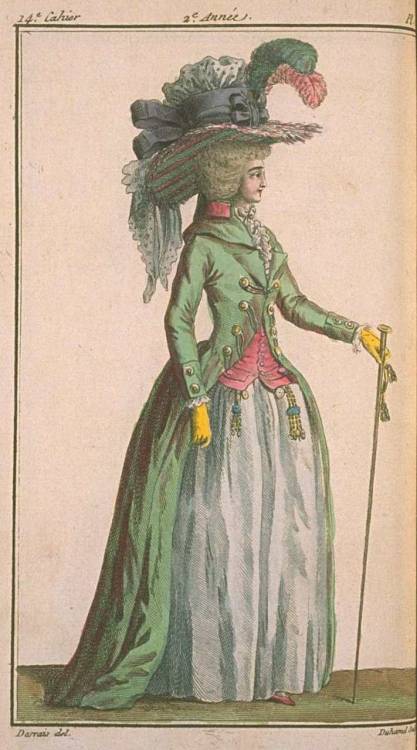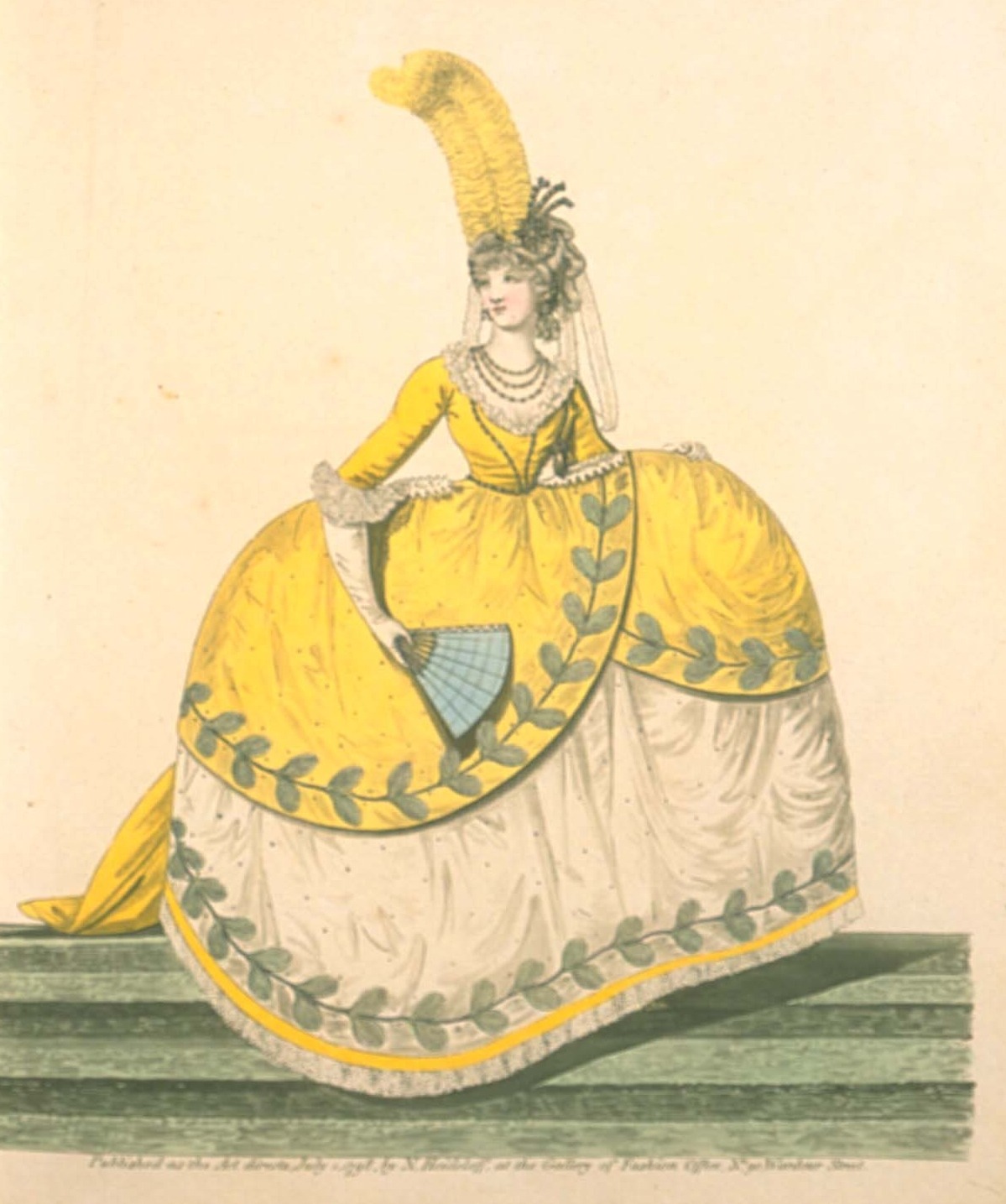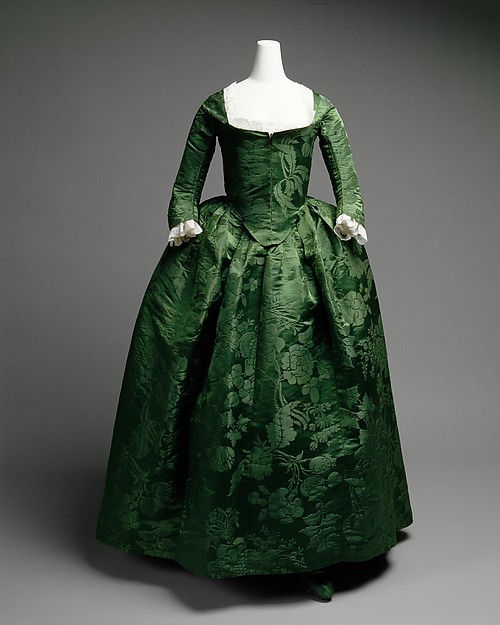I realized today with the 18th century gowns I have made, I have only scratched the surface of how many different types there were. It's easy to fall into the idea that it was all Robe a la Francaise, Robe a l'Anglaise, Robe a la Polonaise, rinse/repeat; but there are really many more than just those, and then all kinds of mooshed up variations too! So I have compiled a rough list of gown types. I will not define these specifically (though I am sure they do have very specific definitions). Ready?
Robe a la Francaise - an iconic gown of the entire 18th century, the Robe a la Francaise, or Sacque, features a pleated back, known as "Watteau pleats." The Robe a la Francaise was commonly worn over panier, and as the century progressed, remained the style of choice for formal occasions.
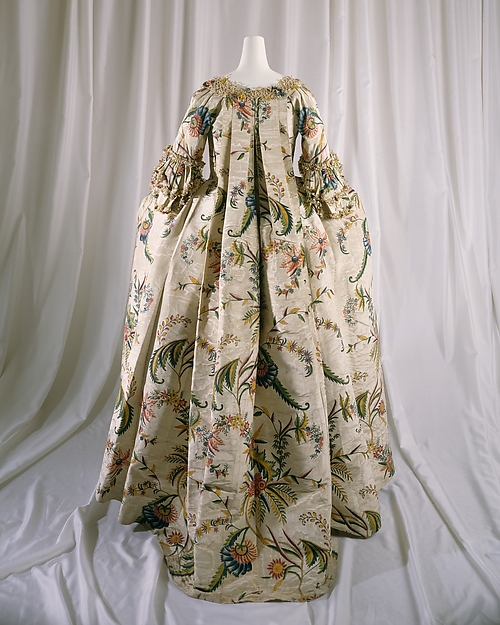 |
| The Met: Robe a la Francaise, 1740s |
Robe Retroussee Dans les Poches - This style of gown entails pulling the skirt fabric up through the pocket slits, created a look we would think "polonaise." The example from the Kyoto Costume Institute shows a Robe a la Francaise worn this way, but a Robe a l'Anglaise can also be worn retroussee dans les poches.
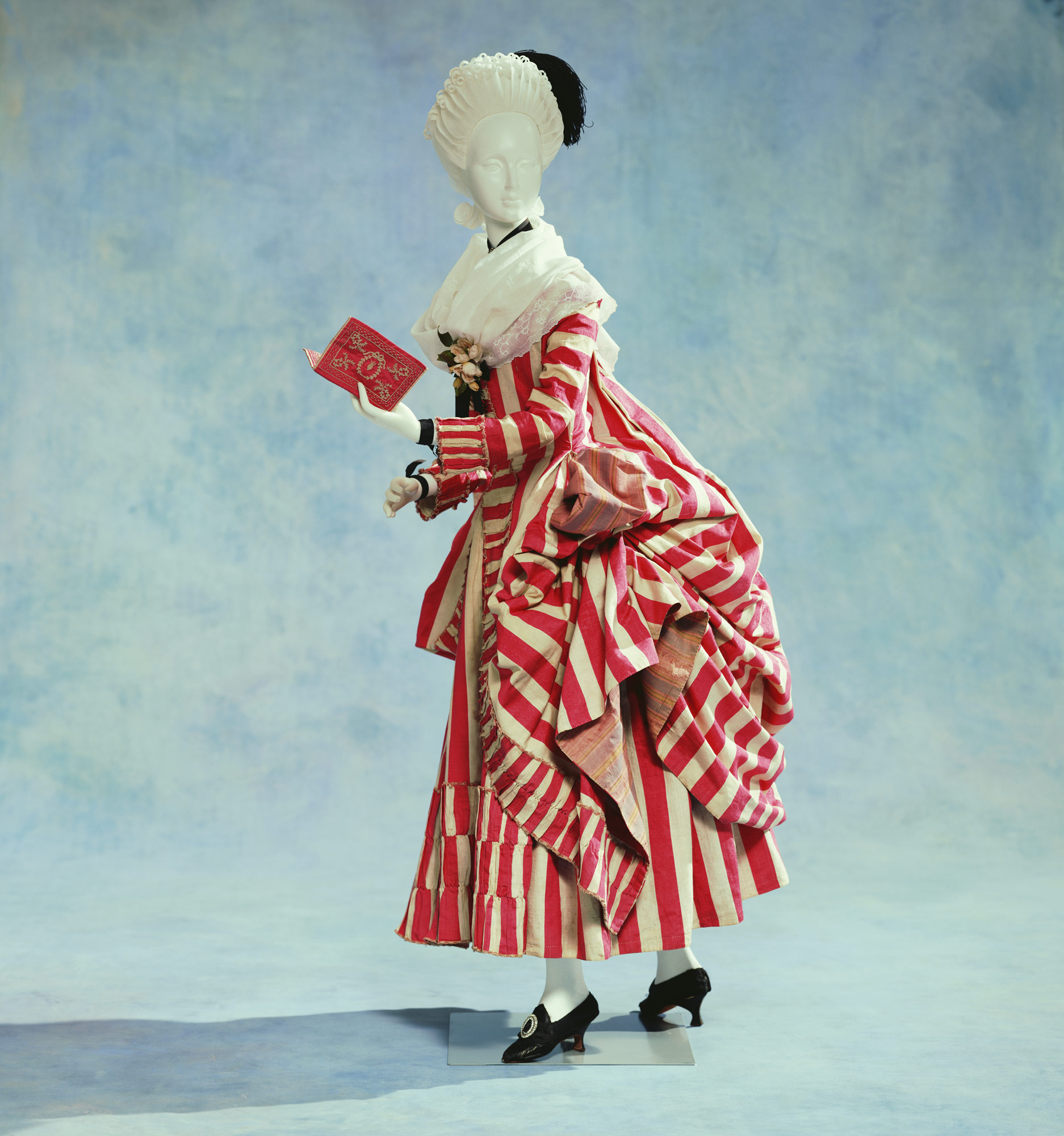 |
| KCI - Robe retroussee dans les poches, 1780 |
Robe a l'Anglaise - The other most common type of 18th century gown is the Robe a l'Anglaise, a style with a tight, fitted back, rather than the draped pleats of the Francaise. Anglaise came in various cuts, and changed throughout the later 18th century - some are open front bodices with stomachers or false fronts, some are closed front bodices with pins or buttons; some are 3/4 sleeves, some have long sleeves, etc.
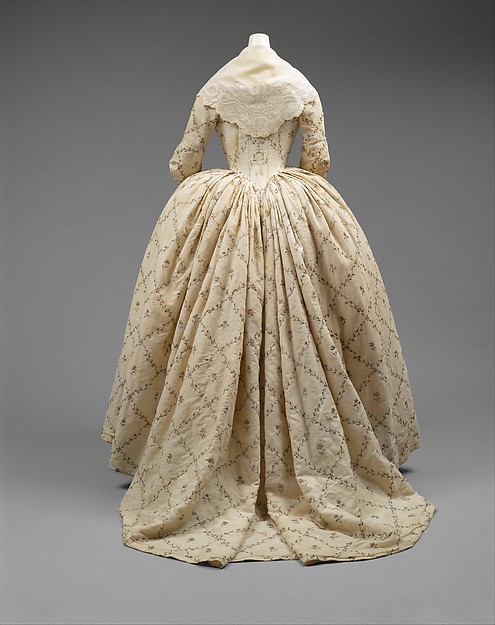 |
| The Met, Robe a l'Anglaise, 1784-87 |
Zone Front Robe a l'Anglaise - Our modern term "zone front" is used to describe a Robe a l'Anglaise bodice that is cutaway at the front, forming an inverted "V" that sweeps back into the skirt of the gown. Stomacher portions of Zone Front gowns sometimes matched the gown fabric, and sometimes didn't. Zone Fronts are stitched down, and end at a waist seam.
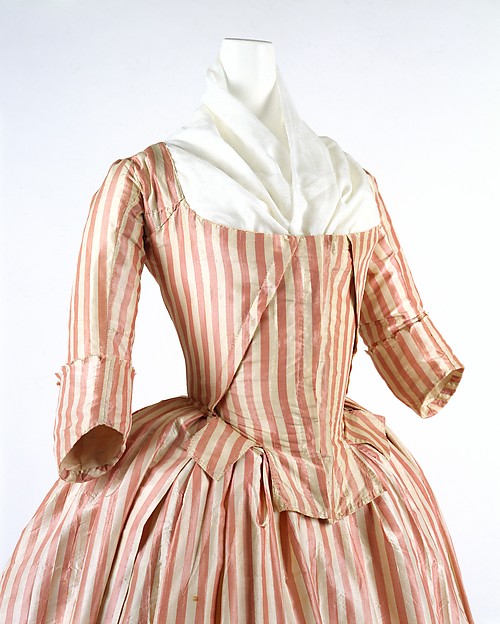 |
| The Met, Robe a l'Anglaise with a zone front, 1785-87 |
Robe a l'Anglaise a la Polonaise - This style of Anglaise is worn with the skirts gathered up. Any Robe a l'Anglaise can be worn this way, with various systems of suspening the skirts. A Robe a l'Anglaise worn a la Polonaise, however, difers from a Robe a la Polonaise.
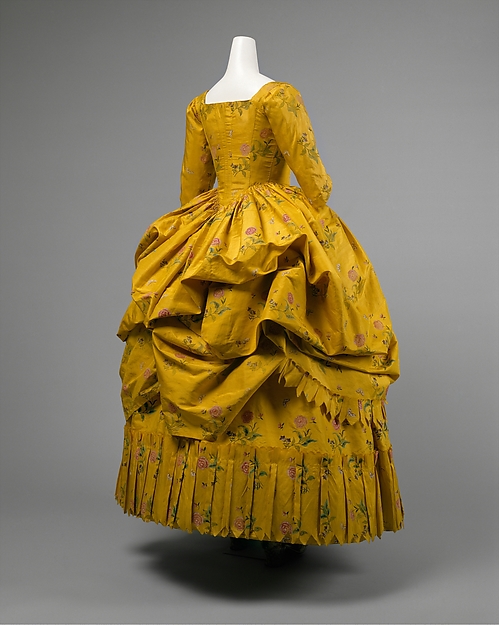 |
| The Met, Robe a l'Anglaise worn a la Polonaise, 1780-85 |
Robe a la Polonaise - This popular style was named for the division of Poland into three parts in 1772, symbolized by the three portions of the skirt, when drawn up. The Robe a la Polonaise also features a cutaway bodice styled like a man's frock coat, and worn over a gilet, or vest. There is no waist seam, and the bodice hangs loosely front the center front. Polonaise gowns could have long or short skirts, and be worn over long or short petticoats that most commonly matched the gown fabric. The Robe a la Polonaise was in fashion in the 1770s and 1780s.
Robe Volante or Robe Battante - This type of gown is much earlier, but I thought I should include it. The Robe Volante, or Battante, was a large, seemingly loose-fitting, draped gown, similar to the Robe a la Francaise, but less structured. The back features loose pleats, as does the front. Volantes were closed in front, but often have stomachers peeking out, and were worn over panier.
Robe en Chemise or Chemise a la Reine - The scandalous fashion of the 1780s was the Robe en Chemise, a gown styled literally from the underwear of the lower classes. Robe en Chemise feature gathered bodices, sometimes cut in one with the skirt. There are various stylings - some have fitted backs, while others have gathered backs; some have full billowing sleeves, while others have long, tight sleeves. Chemise gowns were made of lightweight fabrics in any color, not just white.
 |
| Lady Lemon, 1788, George Romney |
Robe a la Turque - The Robe a la Turque was inspired by what it sounds like - an interest in Middle Eastern fashions. Popular in the 1780s and into the 90s, the Turque appears to be a loose-fitting robe with a shaped front similar to a zone front Anglaise. Like the Polonaise, the back and skirt are cut in one. Its distinguishing features appear to be short sleeves worn over long, a collar at the neckline, and a sash at the waist, though examples exist showing variation - no sash at the waist, and no short sleeves. This makes me think that perhaps the style was as much about the chosen fabrics, colors, and accessories, as it was about the specific cut of the gown.
Cassidy, of A Most Beguiling Accomplishment, goes in to more details and theories about the turque in her excellent article here.+Marquise+de+Aguessenau+wearing+a+robe+a+la+turque+1789.jpg) |
| Elisabeth Vigée-Lebrun, Marquise de Aguessenau wearing a robe a la turque 1789 |
Redingote - The Redingote, named for "Riding Coat," was inspired by men's fashion, and included collars, button fronts or cutaway fronts worn over gilets, long sleeves, and often military inspiration. Unlike earlier riding habits, Redingote skirts extend to the ground and do not include pockets.
Levite - The Levite was a style of casual dress with an exotic flavor, similar to the Turque. This type of gown was casual and often loose-fitting and long-sleeved, with a bodice closing in front, but sometimes left open like a robe. The characteristic accessory of the Levite is the sash tied around the waist. Levites were popular in the 1770s and 80s.
Robe de Cour - The Robe de Cour simply means "Court Dress." It was the most formal gown worn, and is conservative in fashion. Robe de Cour in the 1770s were large trained gowns worn with grand panier, with tightly fitted, rigid bodices closing in back. By the 1790s, not much had changed - Robe de Cour were still worn with panier and a long train, even when the fashion of the day was for slim, classical-inspired looks.
 |
| Marie Antoinette, by Elisabeth Vigee Le Brun, 1778-1789 |
Round Gown - The round gown was a simple style, similar to a Robe a l'Anglaise, with the exception that the skirt and petticoat are as one - it is not an open robe. Popular in the 1770s through the end of the 18th century, the round gown featured a front-closing bodice with no stomacher, and a drop-front skirt.
---------------------------------------
This list is by no means complete, and my descriptions are not at all in-depth. There are yet even *more* styles of gown - Habit de Sultane, Circassiennes, variations on themes - and I did not include any short gown or jackets. Hopefully, though, this will give a brief idea of the variety to be seen in just a few decades of the 18th century. It certainly inspires me to make some of these more obscure or specific styles, rather than my typical Robe a l'Anglaise etc. etc. etc.
So with so many styles to choose from, which is your favorite?








+Marquise+de+Aguessenau+wearing+a+robe+a+la+turque+1789.jpg)
